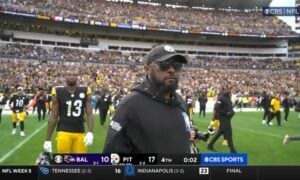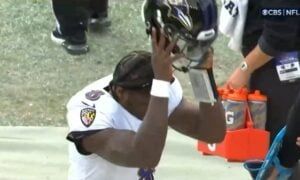By Matthew Marczi
For those of you who follow me on Twitter, you are probably aware of the fact that I took issue with a certain physics-defying aspect of one rule that negated a touchdown run. I speak of course about Le’Veon Bell’s final play.
Bell was looking to cap off a big day with an exclamation point, making a supreme effort and diving into the end zone amidst a series of defenders on what would have set up a potential game-tying two-point conversion.
While he made the required effort to get into the end zone, it came at a heavy price, as he took a head shot from Baltimore Ravens cornerback Jimmy Smith.
While the legality of the hit itself is another topic of conversation, the fact that the hit popped off Bell’s helmet is the crux of the issue.
Because a new rule states that a play is blown dead immediately as soon as a player loses his helmet, Bell’s forward progress was marked off from the moment his helmet popped off his head.
Despite the fact that this act occurred in mid-air.
Now, the intent behind the rule is perfectly understood. The idea is to immediately cease all efforts to bring down the player made vulnerable by the loss of his helmet. Thus, in order to dissuade defenders of any remaining motivation to make a hit, the play is ruled dead immediately in that instant.
But does it really make sense to penalize the offensive player by eliminating his naturally-attained forward progress simply because a defender knocked his helmet off?
I won’t go so far as to say that this play will serve as an example for defenders to start ripping helmets off, but there’s a certain level of common sense missing in the application of this rule, among others.
If a player diving forward in mid-air is contacted and his helmet is jarred loose while in the process of a ‘football move’ that takes him off the ground, it seems to make logical sense to allow that player’s forward progress.
After all, it is no willful act on the part of the ball carrier that his body continues to move forward, as though he could stop himself mid-air as soon as he realizes that his helmet is missing.
The bottom line is, as we all know, that Bell scored on that play in a very intuitively obvious manner. The play serves as a textbook example of a well-intentioned rule displaying its limitations when applied to real-time situations. Not only did it penalize the player who lost his helmet, it also did not protect him from injury. When that happens, it’s time to revisit the rule.







